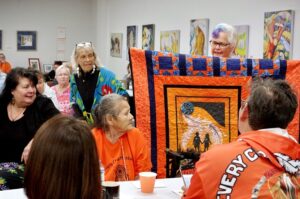Indian Residential School Survivors and families honoured with hand-made quilts
Trigger warning: readers may be triggered by the mention of Indian Residential Schools. To access a 24-hour National Crisis Line, call: 1-866-925-4419. Community Assistance Program (CAP) can be accessed for citizens of the Anishinabek Nation: 1-800-663-1142

By Rick Garrick
FORT WILLIAM — Fort William’s St. Joseph’s Indian Residential School Project and the McCoy family partnered to deliver a Quilts for Survivors Breakfast for Survivors, families, and citizens on Oct. 1 at the CNR Building. The breakfast featured the presentation of quilts made by Dawn Kelly, a McCoy family member, and other quilters to 12 recipients or a family member.
“My mother was Dorothy McCoy,” Kelly says. “When I found out about the initiative for Quilts for Survivors, my goal was to make quilts for Survivors of Residential School who reside on my mother’s reserve. We made 24 quilts in total, 12 came here, and 12 went to Beausoleil First Nation. One of the other girls who was quilting with us, her mother was from Beausoleil.”
Celina McCoy Reitberger, a member of the McCoy family, says they decided it was a perfect time for a family reunion after their cousin, the late artist Virginia McCoy passed away in 2022.
“We started to work on getting her works back to her homeland — it was one of her dreams to have a show here,” Reitberger says. “We found out we have so many relatives on the Fort William First Nation. You can see the result on the storyboard of all the people who are coming, adding their names, and it’s just such a wonderful tribute to family.”
Liz Esquega, who works with St. Joseph’s Indian Residential School Project in Fort William, says the stories shared by the survivors were quite emotional.
“It was very powerful, I’m just overwhelmed,” Esquega says. “The work itself, it’s like you’re delving deeper and deeper as you go along and more and more stories are coming out.”
The quilts were created for survivors Leonard Dick, Belinda Robertson, Vern Kimball, Elizabeth Pelletier, Isobel Cyrette, Ione Bannon, Elizabeth Pervais, Ruth Pervis, Pauline Cyrette, Peter Plummer, Danny Pinasse, and Laura Calmwind, with about half in attendance to receive their quilts.
Kimball says he was a third-generation Indian Residential School Survivor, noting that his grandmother was sent to the Residential School on the Kaministiquia River.
“When my grandmother was there, she retained the language but she didn’t teach it to her children,” Kimball says. “My parents, because they were raised by a parent that wasn’t allowed to speak the language or pass the culture on, didn’t learn to be proper parents, which is sad because their children … didn’t know what love was.”
Pelletier says one of the things she didn’t like about Residential School is they couldn’t write a letter.
“They read our mail incoming and outgoing,” Pelletier says. “I remember one time I had to write my letter home to my mother three times because they just didn’t like what you put in the letters, and you weren’t even putting [in] anything serious. It was just horrible.”
Calmwind, a Kitchenuhmaykoosib Inninuwug citizen and language teacher in Fort William who has lived in the territory since she was sent to high school in Thunder Bay, says she rarely talks about her Residential School experience.
“But there’s one thing I want to share about being a Survivor, is I’ve turned my life around to become a thriver,” Calmwind says. “I’ve made it my job on this earth, because there was an Elder that spoke to me one time and she said, ‘The best thing you can do about what happened to you in Residential School, and we all have a story… the best revenge you can ever have is to live a good life and to speak your language fluently and to practice your ceremonies and do what it is that makes you proud to be Anishinabekwe’.”


